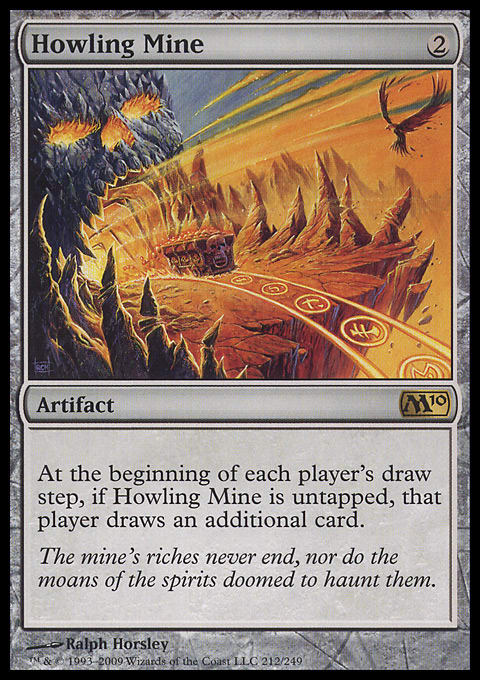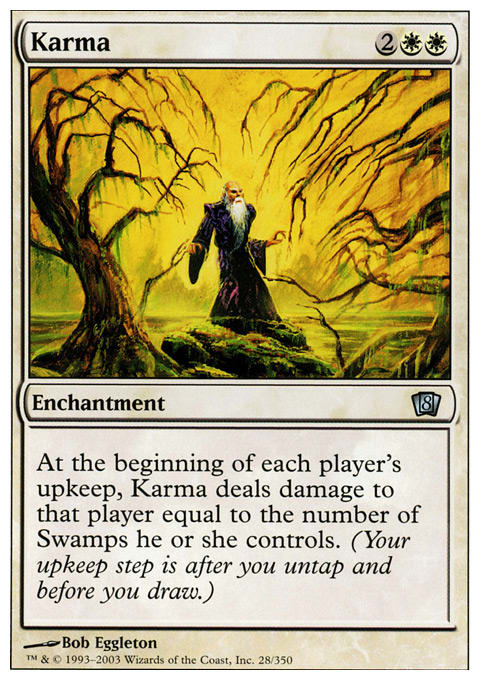I’ve written a lot about balancing in multiplayer theory (here, here and here, for a start). In International Relations, balancing is widely regarded as the main way that countries deal with threats; similarly in multiplayer Magic, balancing against stronger opponents is the main way that players deal with the shifting dynamics of the game. However, balancing involves you doing stuff to your opponents; there's a lot more to learn about how to get your opponents to do stuff to each other.
The fact that balancing is the most common way that threats are eventually overcome doesn’t mean that it should always be your first move. Balancing against a threat uses up your resources and always carries risks. On the other hand, letting your opponents deal with it uses up their resources. This week and next week, I’m going to look at what game theory has to teach the Casual Tribe about the noble art of having someone else solve your problems for you.
Free Riding
This is a key idea that I want to clarify first. The idea of free riders comes from economics, describing people who enjoy public goods (roads, parks, clean water, and so on) without paying for them. In Magic, the classic example of free riding is Howling Mine: The person who plays it loses both mana and a card, and everyone else rides for free on the Howling train. Of course, if the Mine is followed up by an Underworld Dreams, that public good becomes a public enemy, but then the Krosan Grip that blows up the Dreams is a public good.
It is important to understand that neither the Mine player nor the green mage who thwarts the former player’s plans should be worried about the free-rider problem in these particular cases; the former needs to play the Mine as part of his strategy, and the green mage is using his spot removal to deal with a card that threatens him, which is the whole point of spot removal. But everyone else benefits from these cards without paying any costs at all, and over the long game, this kind of advantage can really stack up. In theory, a deck that played only threats and conveniently had all of its opponents’ threats answered by other opponents would have to work very hard to lose the game. In simple terms, the possibility of free riding is a powerful form of card advantage that is unique to multiplayer, so it’s well worth understanding.
The danger of free riding is that free riders don’t take any responsibility for maintaining the system. If enough people ride the train without buying a ticket, the train will stop running; if nobody packs enchantment removal because they all assume the green mage will take care of it, the player with the killer enchantments will usually win. As such, free riding, like any other strategy, entails risks that we have to understand before we rely on it.
Buck-Passing
Passing the buck is a form of free riding in which you refuse to provide a public good, instead relying on other players to do it. Usually, this means holding back your removal so that you gain card advantage when others answer threats for you, although it has broader applications that I’ll get into next week.
The underlying logic of buck-passing is this: If a generically threatening card (a huge creature, powerful planeswalker, or advantage engine) worries you, it stands to reason that it should worry someone else at the table. If you can’t or won’t deal with it, maybe one of your other opponents can. Sometimes, you just can't answer a threat right now, and someone else plays an answer before you can; that’s perfectly natural. Sometimes, you realize you don’t have an answer to a particular card or strategy and someone else does—Darksteel Plate is invulnerable to your artifact-removal suite, but you know the red mage has Into the Core, so you have to rely on him to deal with it, for example.
In the Underworld Dreams example, I may have had a removal spell in hand but held on to it to see if someone else could get rid of the Dreams instead—maybe because I had the highest life, because I was more worried about another enchantment, or because I wanted to draw out enchantment removal so that I could safely play my own killer enchantment. All of these could be considered examples of free riding.
Depending on the threat, the decks everyone else is playing and the cards they have in their hands, relying on your opponents to handle cards that threaten you may or may not work out. Every multiplayer strategy writer will tell you that one of the most important facets of the game is threat assessment, but successfully passing the buck requires you to take your threat assessment to the next level—you need to understand how other players assess threats. Are they threatened by the card that threatens you? Are they threatened enough to use removal on it, if they have removal in hand, or is there another threat that worries them more? Most importantly, would they be prepared to leave a threat on the table for a little while longer because it hurts you more?
Passing the buck only works if you can realistically expect someone else to deal with it. I can’t usually expect the green mage to Naturalize the Karma that threatens my mono-black deck, but the Orzhov mage will almost certainly want it gone. On the other hand, if the Orzhov mage only draws a Disenchant or Mortify after he takes damage from Karma on his upkeep, can I expect him to destroy the Karma right away, or is he more likely to get rid of it after it has hit me on my next turn?1 One of the key truths of multiplayer is that even the people who share your interests are trying to kill you, and this fact is very important in deciding whether the buck should stop with you or you should pass it on to the next player.
A better example of successful buck-passing is one in which I have the answer to a card that threatens the whole table in my hand. Let’s say someone casts a Bosh, Iron Golem with 4 mana untapped and a board full of artifacts, including Spine of Ish Sah. It’s my turn next, and I happen to have Putrefy in my hand and the mana to cast it. Years of playing in duels have taught us the value of mana efficiency and casting instants at the end of our opponent’s turn, suggesting that we should take out Bosh before our turn starts, but the conventional wisdom is wrong here.
Here are the extra factors that a duelist would ignore but a cagey multiplayer veteran would consider:
- I’m not the only one who’s afraid of a massive howitzer like Bosh.
- There’s an excellent chance that someone else has removal for an artifact creature and will want to use it.
- Whoever kills Bosh is likely to wear 8 points of damage and might suffer further reprisals as well.2
- My Putrefy will be better served answering a threat that specifically targets me.
Successful buck-passing relies on a number of factors, but if you find yourself in a situation in which they are all present, you can confidently hold off on dealing with a threat and let your opponents expend their own resources in dealing with it. Buck-passing is best when:
- Other players are threatened by the same things you are.
- Other players are fully capable of dealing with that threat.
- Your answers are fungible.
- You are still relatively safe if your opponents don’t have any answers (or choose not to play them).
Let me emphasize, though, that buck-passing is not the best strategy in all situations. I would have been very reluctant to pass the buck to Nick if, for example, my answer had had been less fungible (hint: not related to Saprolings. It means it can be used for many things). If I found myself with a Hearth Charm, which can only kill artifact creatures, I would have been thrilled to have such a great target for it, and I would have been less inclined to blow up Bosh ASAP. If it was an Ink-Eyes, Servant of Oni instead of Bosh, and I was playing a recursion-based deck, I probably would have tried to take her out immediately because she would have threatened me more than she threatened Nick. Finally, if my answer had been sorcery-speed removal and the threat was more immediate (for example, Bosh, Nim Deathmantle, and enough mana to kill everyone when he untapped), I wouldn’t have taken the risk of passing the buck to Nick, and I would have dealt with the threat on my own.
And just in case this all sounds too theoretical, I faced a similar dilemma in a game this week after I’d started writing this article. I cast Terastodon into a very target-rich environment and thought about using it on the Hall of Gemstone played by the mono-green deck. I chose a different target, though, because I realized that:
- Everyone was suffering under the Hall.
- It was keeping my opponents from playing their commanders (The Mimeoplasm and Olivia Voldaren).
- My Glissa deck was suffering less because I had very few gold cards and a hand full of artifacts.
- The Mimeoplasm would certainly be able to deal with an enchantment, and the Vamps at least had enough mana for Spine of Ish Sah.
- I still had Stomp and Howl in hand, so I could use that next turn if necessary to burn down the Hall.
Sure enough, at the end of my turn, The Mimeoplasm flashed out an answer, destroying the Hall, and making me a very comfortable free rider.
Conclusion
Multiplayer Magic is about resource management, and your opponents can be a valuable resource. On the other hand, Magic is also a game about tempo, meaning that if you don’t answer a threat in time, it can get out of control pretty easily. Passing the buck is therefore a delicate balancing act. It is important to remember that you don’t have to do everything yourself or eliminate every threat immediately, but you do need to answer threats—and be able to answer threat—if your opponents don’t.
Next week, I’ll explore this idea more when I look at the Stag Hunt.
1 There is also the possibility that the devious Orzhov mage played the Karma in the first place and is looking to follow it up with Urborg, Tomb of Yawgmoth.
2 Bosh sacs himself to do 8 damage to whomever tries to kill him or Bosh sacs the Spine to do 7 damage, and then the Spine is replayed next turn, targeting that player’s best card.


























